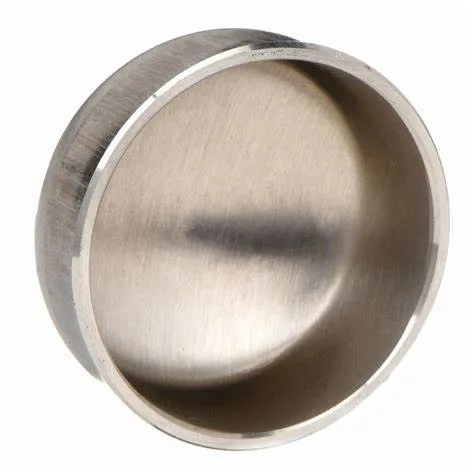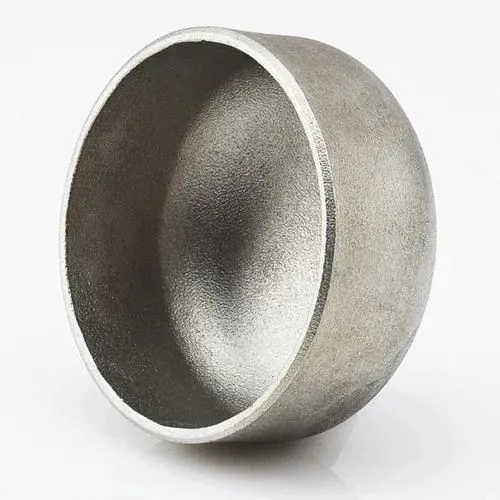JIS B2311 er en japansk industristandard, der dækker stødsvejsningsrørfittings, inklusive hætter, der anvendes i rørsystemer. Stumsvejsehætter tjener det formål at lukke enden af et rør, hvilket giver en tætning for at forhindre lækage eller forurening. Her er en introduktion til JIS B2311 stødsvejsehætter:
- 1. JIS B2311 Standard:
- - JIS B2311-standarden specificerer kravene til design, dimensioner, materialer, fremstilling og test af stumpsvejsefittings, herunder hætter, i rørsystemer.
- - Standarden sikrer, at hætter produceret i overensstemmelse med JIS-standarder opfylder kvalitetsstandarder og er kompatible med andre rørkomponenter.
- 2. Butt-svejsehætte:
- - En stumpsvejsehætte, ifølge JIS B2311, er en fitting designet til at dække og forsegle enden af et rør sikkert, hvilket giver beskyttelse og opretholder integriteten af rørsystemet.
- - Hætter bruges i situationer, hvor rørenden kræver lukning, enten permanent eller midlertidigt, for at forhindre lækage, forurening eller for at give en finish til systemet.
- 3. Materiale og konstruktion:
- - Stumsvejsehætter under JIS B2311 specifikationer er tilgængelige i forskellige materialer såsom kulstofstål, rustfrit stål og legeret stål for at opfylde forskellige anvendelseskrav.
- - Disse hætter er fremstillet ved hjælp af standardiserede konstruktionsmetoder for at sikre en stærk og lækagefri forbindelse, når de svejses til enden af et rør.
- 4. Ansøgning og fordele:
- - Stumsvejsehætter finder anvendelse i forskellige industrier, herunder olie og gas, kemiske processer, vandbehandlingsanlæg og mere, hvor rørenderne skal lukkes sikkert.
- - Hætter giver beskyttelse til rørender mod miljømæssige elementer, forhindrer forurening og hjælper med at opretholde renheden og integriteten af rørsystemet.
- 5. Installation og svejsning:
- - Korrekt installationspraksis, herunder korrekt justering, forberedelse af rørenden og svejseteknikker, er afgørende, når du installerer stødsvejsehætter for at sikre en tæt og lækagesikker tætning.
- - Svejsning er en almindelig metode til at fastgøre hætter til rør, hvilket giver en sikker og permanent lukning, der kan modstå tryk, temperaturvariationer og væskeflow i systemet.
- Sammenfattende er JIS B2311 stødsvejsehætter afgørende komponenter, der bruges i rørsystemer til at forsegle og beskytte enden af rørene sikkert. Disse hætter er i overensstemmelse med standardiserede krav for at sikre kvalitet, pålidelighed og kompatibilitet inden for industrielle applikationer, hvor rørlukning og -beskyttelse er nødvendig.
What Is a Butt Welding Cap and How Is It Used in Industrial Piping?
In industrial piping systems, end-of-line sealing and branch closures require robust solutions. A butt welding cap serves as a critical component for terminating pipes securely. By providing a seamless, welded closure, this fitting maintains system integrity, prevents leaks, and supports compliance with industry standards.
What Is a Butt Welding Cap?
A butt welding cap—also called a pipe end cap or buttweld end cap—is a round fitting designed to close off the end of a pipe. It’s manufactured to match the pipe’s outer diameter and schedule, with either a hemispherical or flat face. To install, both the pipe end and cap are beveled to form a V‑groove, enabling full‑penetration, fusion welds. Common materials include carbon steel, stainless steel, nickel alloys, and other engineered grades, chosen to satisfy pressure, temperature, and corrosion‑resistance requirements.
How Is Butt Welding Cap Used in Industrial Piping?
Butt welding caps find application across oil & gas, petrochemical, power generation, water treatment, and general process industries for both permanent and temporary closures. During hydrostatic testing, technicians install caps to seal off sections of piping while monitoring for leaks. In new construction or retrofit projects, caps terminate branch lines, future tie‑in spools, or dead‑end mains until system expansion. Welders prepare each joint by cleaning and beveling surfaces, aligning the cap precisely, and executing a root pass followed by filler passes per the qualified Welding Procedure Specification (WPS). Post‑weld heat treatment and non‑destructive examination (NDE)—such as radiography or ultrasonic testing—verify weld integrity and compliance with ASME B16.9 and related standards. Additionally, temporary caps enable safe isolation during maintenance, allowing for segment testing and dewatering under regulatory protocols.
Benefits and Best Practices
Butt welding caps offer a smooth‑bore transition that minimizes flow disruption and stress concentration. Their full‑penetration welds deliver exceptional structural strength and leak resistance. To optimize performance, engineers should:
Select caps with matching material grades and wall thicknesses
Adhere to proper bevel angles and joint fit‑up tolerances
Follow qualified WPS protocols rigorously
Consider cladding or protective coatings in corrosive environments to extend service life
Regular inspection and thorough documentation ensure long‑term reliability and safe operation under demanding conditions.
Butt welding caps are indispensable components for achieving durable, leak‑proof pipe terminations in a wide range of industrial applications.
Butt Welding Cap FAQs
What is a butt welding cap?
|
What materials are commonly used?
|
What standards govern butt welding caps?
|
How are butt welding caps installed?
|
Where are butt welding caps typically used?
|
What are the advantages of threaded caps?
|
















